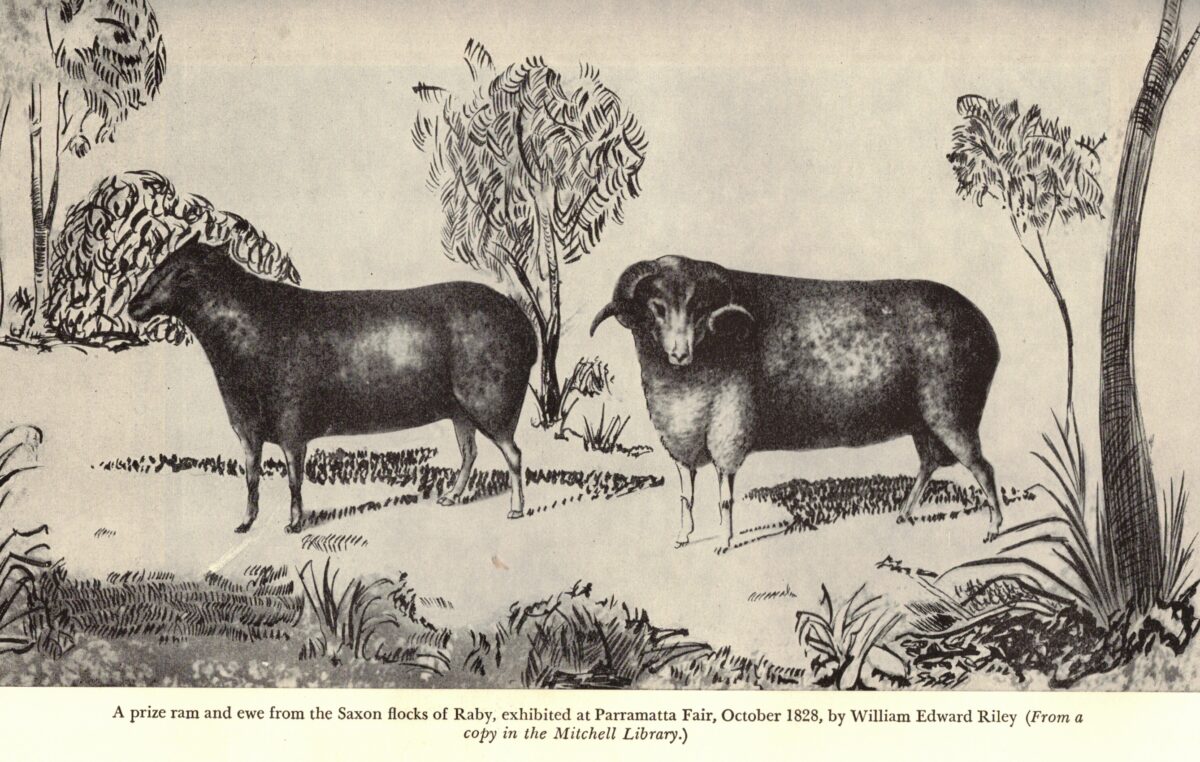Saxon Sheep and Shepherds
Featured Image: Raby bred Saxon Sheep exhibited at Parramatta Fair, October 1828, by William Edward Riley
Acknowledge: ‘Dawn in the Valley’ by W. Allan Wood (1972) ISBN 0 85587 027 3
Apart from the Macarthur Merinos the most original sheep to come to New South Wales up to 1825 were derived from India. They were unsightly and diminutive, covered with long course hair and resembling a goat in appearance.
In 1794 John Macarthur purchased 60 coarse-haired Bengal ewes and lambs which had been imported from Calcutta. Tibetan sheep came down through the passes from Sikkim and Darjeeling to be shipped to NSW via the Bay of Bengal. They were known in Australia as ‘Bengal Sheep’.
Merchant and entrepreneur Richard Jones purchased 30 ewes and a few rams at small fairs near Leipzig (Saxony) at £12 for rams and £5 for ewes. The total expense of landing the 120 sheep at Sydney via London was £2,407-8-9. These were shipped to NSW on the Prince Regent, Elizabeth, and Hugh Crawford. A second lot of 4 Saxon Rams, 160 Saxon Ewes plus 4 Merino Rams and 200 Merino Ewes were transported on the Saracen. Richard Jones himself returned to Sydney in the Hugh Crawford, arriving on 3 April 1825 accompanied by family members his wife and son Richard (aged 2), and younger siblings Edward and Elizabeth Jones.
The Saxon breed were pioneered in the Upper Hunter by George Blaxland, Captain Pike (Pickering), Francis Forbes (Skellatar), Peter Cunningham (Dalswinton), William Ogilvie (Merton), William Cox (Negoa/Wybong) and Henry Dumaresq (St Helier’s). Thomas Potter Macqueen (Segenhoe) also acquired early Saxon imports. Perhaps the most entrepreneurial was James Brindley Bettington (Brindley Park, Gummun Plains) who purchased Saxon sheep from Prince Esterhazy’s flock in Silesia. Fred Becker accompanied the sheep and was known as ‘German Fred’. In the course of time stations of the Bettington partnership were located on the Mooki, Namoi, Baradine, Castlereagh, Talbragar, Macquarie, Gwydir, Horton and Manilla Rivers extending throughout the New England, Darling Downs and the Maranoa. The blood of Brindley Park was strong in many other Australian flocks.
“The Saxon sheep throve and generated in this country beyond all expectations, but it was considered that certain cardinal rules must be observed in order to grow fleeces which would be sought after in England. The flocks must be kept off the rich herbage of the river flats in good seasons and grazed in open shade country in Summer. In the heat of the day the sheep must be rested in the shade and not allowed to crowd together. The wool must be well washed before shearing, well pressed and packed, free of seeds and burrs, and brought to auction in England as quickly as the state of the roads and the vagaries of shipping would allow”.
In 16 years from 1819 the annual export of wool from New South Wales multiplied 53 times. From 71,299 lbs in 1819, it increased to 3,778,847 lbs in 1835. The great Collaroy Station, 47 miles from Merton on the Krui River, was formed by Sydney Richard Jones and W. S. Davidson. Merton bred Saxon Merinos were taken via Tenterfield to Yulgilbar on the Clarence River near present day Grafton.










